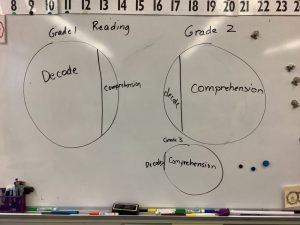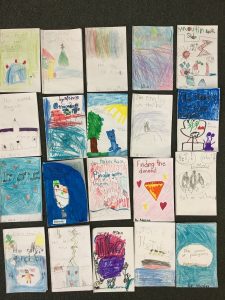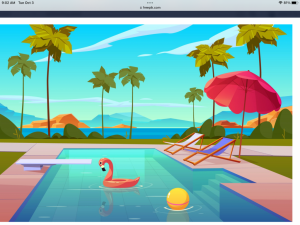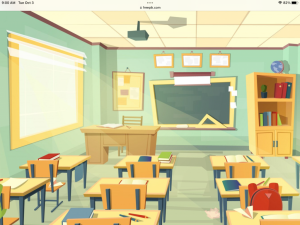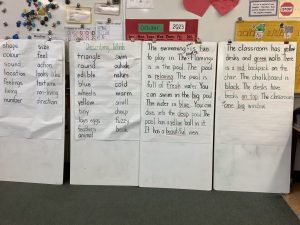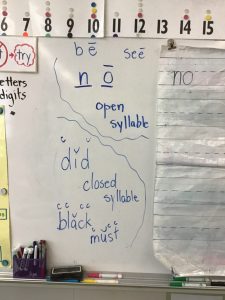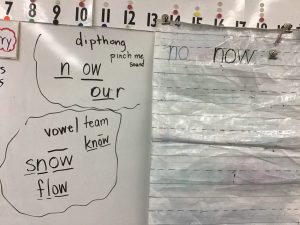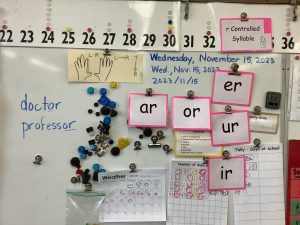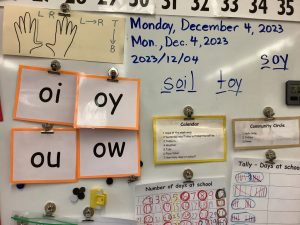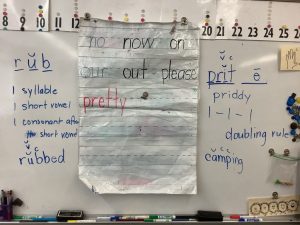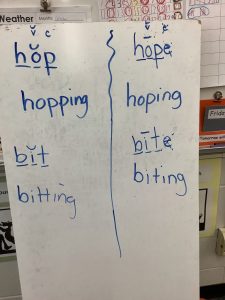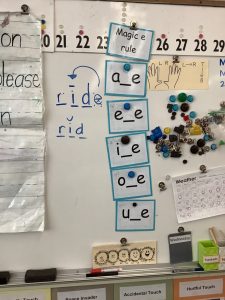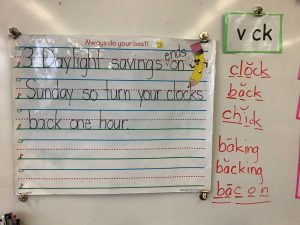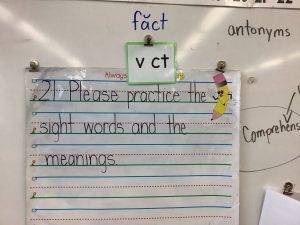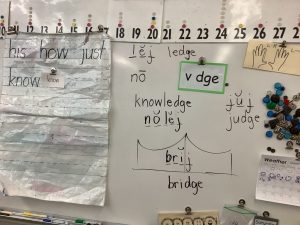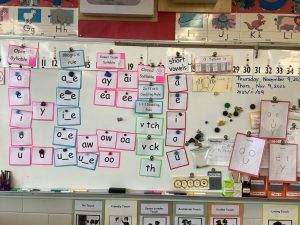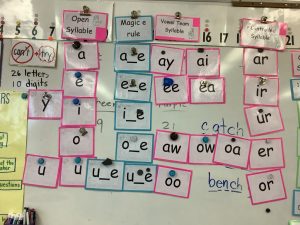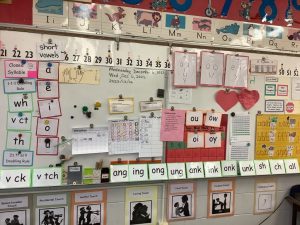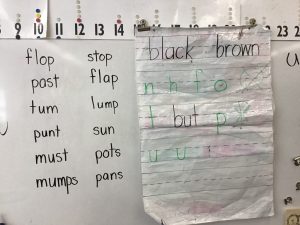Our Learning (Literacy)
Components of Reading
Reading has two components, decoding and comprehension. When we begin learning to read, the decoding component is really important. We need to figure out what the letters on the page mean. As we become more familiar with reading, the comprehension becomes important. This is what we do for the remainder of our lives, which is understanding what information is given by the words. If decoding is still weak, we need to strengthen it so we can move onto the comprehension.
Story Workshop
On Apr. 16, we continued to use the grid to show us how stories follow a logical progression. This week, we used the story, The Three Little Pigs, retold by Barry Moser.
To help with the concept of proper progressions in a story, we used the story Goldilocks and the Three Bears to help us see how the plot follows a sequence of progressions. We also used a grid with arrows, similar to coding and its step by step progression, to help us follow a sequence of progressions to help us orally retell the story.
The book covers of our first book. We began writing our books on Jan. 23 and finished them the week of Feb. 19.
We began creating a story using loose parts.
On the week of Oct. 23, we continued working on writing sentences using describing words. We created a paragraph together as a class where each table group gave a sentence. I have put the paragraphs and the picture they were describing so you can see the great job they did.
Frequently Used Words
Also known as “high frequency words” or “sight words” are words that are common in many books we read. Becoming familiar with these words will help in the decoding process of reading. This year, I will use the term “high frequency words” to denote words that can be sounded out phonetically and/or follow the grammatical rules and I will have your child print these words in black. The “true sight words” are words that cannot be sounded out as they do not “follow the grammatical rules”. Please note that the words that are italicized and in bold print. I have your child print these words in red to help them recognize that they need to be memorized. Below is a list of “Pre-Primer Words” which are found in many of the books we read but are also found in preschool school aged books. These words are now posted on the word wall in the classroom and are what I call the “secrets to reading”, This will help your child build reading fluency and writing.
Here are the Pre-primer words that should already be familiar to the students. They are posted on the word wall.
a, and, away, big, blue, can, come, down, find, for, funny, help, here, I, in, is, it, jump, little, look, make, me, my, not, one, play, red, run, said, see, the, three, to, two, up, we, where, yellow, you
Starting September 12, we began a new set of words that have a “p”. The “p” symbolizes “Primer”, which are words found in books that are geared towards Kindergarten level. Of course these words are found in any level books, but they begin to be more frequent in those levels. We are now putting the new words within the word wall and learning to alphabetize with each new word (putting words in alphabetical order).
We have also have been learning to put the words in alphabetical order.
Homophones
The term ‘homophones’ are used for words that sound the same but are different words. Examples: four and for; hear and here; one and won; see and sea
Homonyms
The term ‘homonyms’ are used for words that are spelled the same but have two or more meanings. Examples: well (meaning good and a pit/hole that holds water)
Red Words
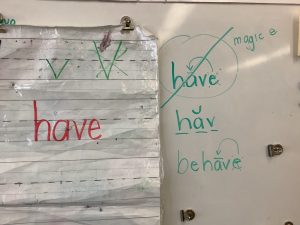 The word, have, is a red word because it does not follow the ‘magic e’ rule (the magic e makes the vowel say its own name). In ‘have’, the a makes a short vowel sound.
The word, have, is a red word because it does not follow the ‘magic e’ rule (the magic e makes the vowel say its own name). In ‘have’, the a makes a short vowel sound.
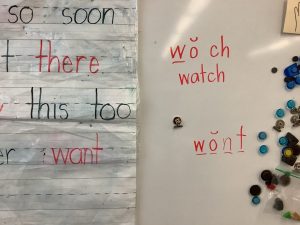 The word ‘want’ is a red word because the ‘a’ makes the sound of /o/short vowel.
The word ‘want’ is a red word because the ‘a’ makes the sound of /o/short vowel.
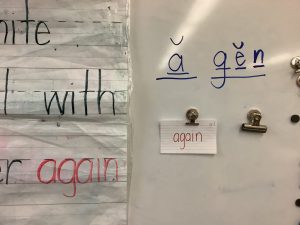 The word ‘again’ is a red word because the ‘ai’ makes a /e/short vowel sound.
The word ‘again’ is a red word because the ‘ai’ makes a /e/short vowel sound.
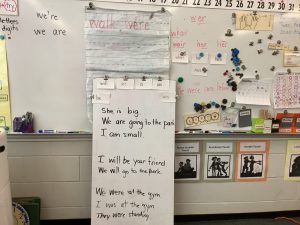 The word ‘were’ is an irregular verb from the verb, ‘to be’. These are all the various forms.
The word ‘were’ is an irregular verb from the verb, ‘to be’. These are all the various forms.
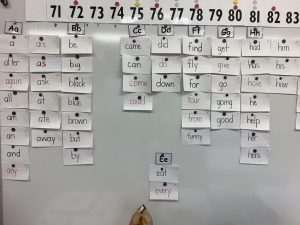
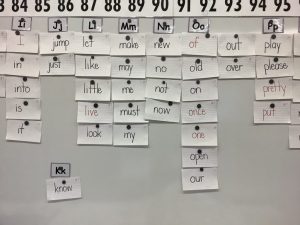
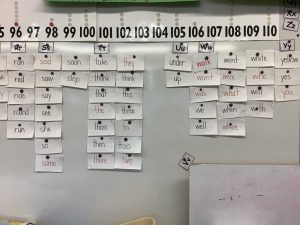 The list of words up to and including Feb. 14.
The list of words up to and including Feb. 14.
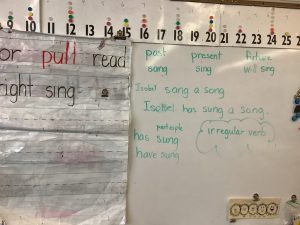 The word sing is an irregular verb. The word changes depending on the verb tense that we are using.
The word sing is an irregular verb. The word changes depending on the verb tense that we are using.
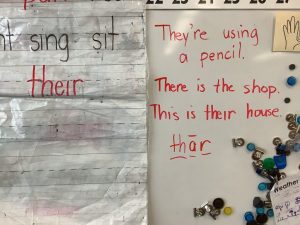 The word ‘their’ is a homophone to ‘there’ and ‘they’re’.
The word ‘their’ is a homophone to ‘there’ and ‘they’re’.
- all
- am – irregular verb; only goes with I
- are – this word is the verb “to be” and used when the subject (we, you, they) is the plural form. It has a silent e but does not follow the silent e rule.
- at
- ate (magic e)
- be (open syllable)
- black (v ck – “vowel ck” – when there is a short vowel and /k/ that follows, we must squeeze in the c; brick, back, pick)
- brown (ow dipthong – we begin and end with a different sound when we say the o and w; the “pinch me sound”, what we say when someone pinches us)
- but
- came – magic e; irregular verb
- did – this word is an irregular verb as it doesn’t follow the past tense rule (present tense is ‘do’)
- do – the /o/ is pronounced like /oo/; also this word is an irregular verb as it doesn’t follow the past tense rule (present tense is ‘did’)
- eat – irregular verb
- four – the /ou/ does not make a “pinch me sound”; this word is a homophone to for
- get – irregular verb
- good
- have – this word does not follow the Magic e rule (the silent e at the end of the word makes the vowel say its own name)
- he (open syllable)
- into
- like (magic e/vowel e syllable)
- must (closed syllable)
- new (vowel team syllable)
- no (open syllable)
- now – I have taught them that the ‘ow‘ is the the “pinch me sound” (what we say when someone pinches us). ‘ow’ also makes the /o/long vowel sound.
- on
- our – I have taught them that the ‘ou‘ is the the “pinch me sound” (what we say when someone pinches us). ‘ou’ also makes the /o/long vowel sound.
- out – I have taught them that the ‘ou‘ is the the “pinch me sound” (what we say when someone pinches us). ‘ou’ also makes the /o/long vowel sound.
- please – has a ‘vowel team syllable’ where there are two vowels together; s also makes a /z/ sound as it is near a silent e
- pretty – we hear a short vowel /i/ and not the short vowel /e/, and the t is usually pronounced as a /d/; there is also the 1-1-1 doubling rule; y makes the ‘happy e’ sound
- ran (past tense of run; run is a verb {action word}, but is an irregular verb which means that when the tense changes, so does the spelling. Most words, we put an ‘ed’ at the end to signify having completed the verb, as in jumped or played, but with run, the word changes to ran)
- ride – “magic e” word
- saw – past tense of see; see is a verb {action word}, but is an irregular verb which means that when the tense changes, so does the spelling. Most words, we put an ‘ed’ at the end to signify having completed the verb, as in jumped or played, but with see, the past tense is saw
- say – open syllable; vowel team syllable
- so – open syllable
- soon – vowel team syllable
- that – voiced th
- there– it has an “ere” which says /ear/ as in the word “here”, but says /air/
- they – this has a long a sound at the end of word as in the word “away
- this – voiced th
- too – This word means also. It is also a homophone of “to” and “two”. Homonym or homophones are words that sound the same, but are completely different
- under – has a r-controlled syllable
- want – this word has a short vowel /o/ sound
- was – this word has a short vowel /u/ sound
- well – this word has two meanings and is known as a homonym
- went – this word is an irregular verb as it doesn’t follow the past tense rule (present tense is ‘go’)
- what – this word has a short vowel /u/ sound
- white – this is a ‘magic e’ word with a /wh/, not /w/ (see /wh/ digraph)
- who – this word has the sound /h/ /oo/
- will – this word is connected to the verb “to be”; future tense
- with
- yes – antonym of ‘no’
- after – has r controlled syllable
- again– this word sounds /a/(short vowel a) /g/ /e/(short vowel e) /n/
- an – this word is used to mean one and is used when the succeeding word begins with vowel sound
- any – this word has a short vowel /e/ sound at the beginning
- as – this word has the /z/ sound at the end; s that makes a /z/ sound is when it is near a magic e or when it is a plural
- ask
- by – this word is an open syllable and follows the rule about y travelling in the word, it becomes a stick vowel sound
- could – this word has a /oo/ sound in addition to not sounding the /l/ sound
- every – this word does not make the /er/ sound; instead, we only hear the /r/ sound
- fly – this word is an open syllable and follows the rule about y travelling in the word, it becomes a stick vowel sound
- from – this word has a short vowel /u/ sound
- give – this word does not follow the magic e rule because it has a short vowel /i/ sound
- going
- had – this word is the past tense of the irregular verb, have
- has – this word is the third singular present tense of the irregular verb, have
- her – pronoun
- him – pronoun
- his – pronoun
- how – this word has a dipthong
- just – this word is a closed syllable
- know – this word has an open syllable and a silent k
- let
- live – this word has a short vowel /i/ sound and does not follow the magic e rule; however, it can also be pronounced using the magic e when describing animals
- may – this word has a vowel team syllable (ay) and is an open syllable
- of – this word has a /u/short vowel sound and the f says /v/
- old
- once – this word has /w/ at the beginning and has the /u/short vowel sound
- open
- over
- put – this word has a /oo/ sound rather than a /u/short vowel
- round
- some – homophone as it sounds like /sum/
- stop – this word is a closed syllable
- take – this word is a magic e
- thank – this word is a closed syllable
- them – this word is a closed syllable
- then – this word is a closed syllable
- think – this word is a closed syllable
- walk – /l/ cannot be heard in this word
- were – sounds like /wer/
- when
- always
- around
- because – this word sounds like /b/ /e/long vowel /k/ /u/short vowel /z/
- been – this word is often sounds like /b/ /i/short vowel /n/
- before
- best – this word is a closed syllable
- both – the o in this word makes /o/long vowel
- buy – this word is a homophone to by and bye
- call
- cold
- does – this word makes a /u/short vowel sound
- don’t – this word is a contraction for do not
- fast – this word is a closed syllable
- first – this word is a ordinal number and has an r-controlled syllable
- five – this word is a magic e word
- found – this word has a dipthong ‘ou’
- gave – this word is a magic e word
- goes – this word is an irregular
- gone – this word does not follow the rules
- green – this word has a vowel team
- its (possessive not to be confused with it’s, which is a contraction for it is)
- made – this word is a magic e word
- many – this word has a short vowel /e/ sound instead of short vowel /a/
- off – this word follows the zsfl rule (“Buzz Off Miss Pill”)
- or – this word is a conjunction and is used when having to choose between two or more things
- pull
- read – this word is a homophone: red and read (past tense)
- right – this word is a homophone (right, write, rite) and homonym [right (direction) and right (correct)]
- sing – this word is an irregular verb
- sit – this word is an irregular verb
- tell – this word is an irregular verb
- their – this word has an “eir” but says /air/
- these – this word is a pronoun to indicate things close to us
- those – this word is a pronoun to indicate things that are away from us
Phonemic Awareness
We began working on phonemic awareness on September 18. We are basically working on the alphabet sounds as they are an important component to the spelling work we will be doing next month. As reading and writing go hand in hand, it is important to know the basic sounds made by the letters as there are many exceptions the rules that we learn in English. Although children often become fluent readers before becoming fluent writers, the two go hand in hand. The letters have names, like we do, but they also have a sound that they say (these are called phonemes). These sounds will changed depending on the letters beside them and the phonetic rules. The slant marks on either side of the letter are called “virgules” (/_/) and they indicate the sound that they make. Letters are either vowels or consonants. The placement of their tongue, whether the mouth is open or closed, and whether we blow through our teeth change the sound of the letter. Formulation of the sounds (articulation) is important when speaking, but it is important in reading and writing as well.
Voiced and Unvoiced ‘th’ (/th/)
When ‘th’ is unvoiced, the air in our mouth is pushed through past our tongue. When ‘th’ is voiced, the sound comes from our throat and pushes past our tongue but passing through the vocal cords creates a vibration.
Sounding out Phonemes
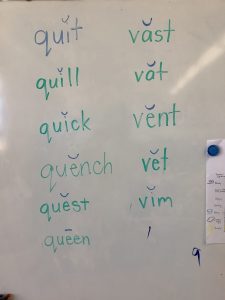
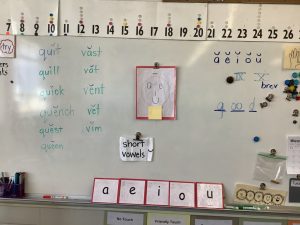 There are five vowels, which are a, e, i, o, u. We have been learning the short vowel sounds. The job of the vowels is to ‘stick words together’ because if we did not have vowels, we would not have any words. The little u shape mark above the vowel is known as a brev, which denotes the short vowel sound. The short straight line denotes a long vowel sound and is known as a macron.
There are five vowels, which are a, e, i, o, u. We have been learning the short vowel sounds. The job of the vowels is to ‘stick words together’ because if we did not have vowels, we would not have any words. The little u shape mark above the vowel is known as a brev, which denotes the short vowel sound. The short straight line denotes a long vowel sound and is known as a macron.
Importance of the Vowels
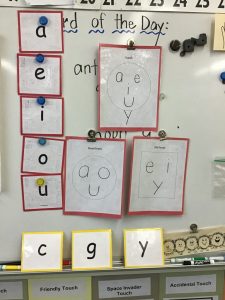 The job of the vowels are the ‘stick words together’ and there is a vowel sound in each syllable.
The job of the vowels are the ‘stick words together’ and there is a vowel sound in each syllable.
With relation to the words that begin with the /k/ sound, words that have a “round vowel sound” after the /k/ usually use a ‘c’ like cat, camp, cot, or cantaloupe, and words that have a “stick vowel sound” after the /k/ sound usually use a ‘k’ like kick, kitten, or keep. ‘Kangaroo’ is the only exception I can think of.
- /hard g/ sound also goes with the round letter to make words like ‘goat’, ‘gust’, ‘gap’
- /soft g/ sounds like /j/ when e or i stands beside the g such as ‘George’, ‘giraffe’, ‘ginger’, ‘generation’ (example of some exceptions: get, gift)
- If the y ‘travels’ to a different part of the word, it usually takes the sound of /e/ or /i/, short or long vowel. Examples: sky, happy, lymph, my)
Alphabet sounds
- /a/ (short vowel sound as in apple) (mouth wide open, tongue is in the mouth but visible)
- /s/ (as in snake) (teeth clenched and lips open)
- /m/ (as in mitten) (lips are together like we are humming)
- /l/ (as in leg) (tongue is out touching our upper front teeth)
- /n/ (as in nest) (face is scrunched and make a nasally sound)
- /f/ (as in feather) (top upper teeth are over our bottom lip and blow)
- /o/ (short vowel sound as in octopus) (mouth is open make)
- /t/ (as in teapot) (quick sound where the air is pushed out of the mouth)
- /p/ (as in pig) (quick sound where the air is pushed out of the mouth)
- /u/ (short vowel sound as in up or umbrella)
- /d/ (as in dog) (quick sound and voiced)
- /c/ (hard c as in cat)
- /k/ (as in kite; has the same sound as “hard c” sound)
- /g/ (hard g as in goat)
- /b/ (as in bat the ball)
- /i/ (short vowel sound as in itch insect)
- /j/ (as in jam)
- /h/ (as in hat. This sound is what is known as “unvoiced” as we the h sound is just the air coming out of our mouth, not through our vocal cords)
- /e/ (short vowel sound as in Ed, elephant)
- /r/ (this sounds like ‘ruh’ as in red rabbit)
- qu/ (/kw/ {k and w sounds together} as in quiet queen. q in the English language is always together with u.)
- /v/ (as in vase)
- /w/ (as in wagon)
- /z/ (as in zebra)
- /x/ (/ks/ {k and s sounds together} as in fox in a box
- /y/ (this sounds like ‘yuh’ as in yo-yo, and it only say ‘yuh’ at the beginning of the word)
Syllables
Syllable – “A word or part of word with one vowel sound or beat”: Evan has two syllables (/e/short vowel in the first syllable, and /v//a/ short vowel /n/ in the second syllable); Alessandra has four syllables (/a/short vowel in the first syllable, /l//e/short vowel /s/ in the second syllable, /s/ /a/short vowel /n/ in the third syllable, and /d/ /ra/ in the fourth syllable)
- Closed Syllable – the symbol that we use with our hand is a closed fist with our thumb inside, like it is protected by the fingers. (a closed syllable is a word or syllable where the short vowel is protected by one or more consonants such as ‘cvc’ or ‘cvcc’. Examples would be cat, bend, fling, toss, or sprung.) ‘cvc’ is consonant vowel consonant, and ‘cvcc’ is consonant vowel consonant consonant
- Open Syllable – The symbol that we use is an open hand like the gesture the police use when they are signaling someone to stop. (an open syllable is a a word or part of a word that is at the end and has a long vowel sound. Examples are words like no, he, donut [do nut], spider [spi der], became [be came], or pecan [pe can]; y that makes the long vowel /i/ (the only time y has the /y/ sound as in yellow or you is when y is at the beginning of the word. When y travels to a different part of the word, it changes what it says. When we hear a long vowel /i/ at the end of the syllable, it is usually the y in word such as fly, cry, standby, satisfy, spry,… Further, if there is a ‘y’ at the end of a word, it can also be “The happy e sound” found in words such as funny, happy, slowly…)
- Diphthong – a vowel team syllable that starts with one sound and ends with another. ow – this makes the ‘pinch me’ /ow/ sound in words such as cow, how, now, meow; oy – this makes the /oi/ sound in words such as toy, Troy, employ, enjoy (often at the end of the base word); oi – the sound in words such as boil, choice, point, join (often in the middle of the word); ou – this makes the ‘pinch me’ /ow/ sound in words such as our, aloud, about (often in the middle of the word)
- Vowel Team Syllable – the symbol we use is like the “peace” sign. This is when two or more syllables work together to make one vowel sound within a syllable. Most often, these vowel team syllables are the long vowel of the first vowel (“When two vowels go walking, the first one does the talking.”) From time to time, you will get the short vowel sound like bread or thread, where you hear the short vowel /e/. These will become more familiar as the students read more and more books. ee – this makes the long /e/ sound in words such as feet, keep, indeed; ai – this makes the long /a/ sound in words such as nail, afraid, sprain; oa – this makes the long /o/ sound in words such as boat, moan, unload; aw – this makes a short vowel/o/ sound in words such as straw, claw, paw, saw; ea – this makes a long vowel /e/ sound in words such as meat, clean, feast, but also makes a short vowel /e/ sound in words like bread, breath, weather; /oo/ makes a long vowel u like in July or ruin and is an open syllable; ay – this makes a long vowel /a/ sound in words such as day, stay, pathway; /ow/ makes a long vowel o sound like snow, know, tomorrow
- r Controlled Syllable – The symbol we use is like the open syllable with the thumb folded in. This is when the r controls the vowel so that the vowel is neither a short or long sound and is blended in with the r. These will become more familiar with more reading. or – this makes the sound in words such as fork, storm, born, sort; er – this makes the /er/ sound in words like her, brother, sister, weather; ar – this makes the /ar/ sound like a pirate in words such as cart, park, market; ur – this sound makes an /er/ sound in words such as fur, curtain, and Murphy; ir – this makes the /er/ sound in words such as bird, fir, birch, third, and first
- Diphthong – a vowel team syllable that starts with one sound and ends with another. ow – this makes the ‘pinch me’ /ow/ sound in words such as cow, how, now, meow; oy – this makes the /oi/ sound in words such as toy, Troy, employ, enjoy (often at the end of the base word); oi – the sound in words such as boil, choice, point, join (often in the middle of the word); ou – this makes the ‘pinch me’ /ow/ sound in words such as our, aloud, about (often in the middle of the word)
Rules
There are certain spelling rules that we follow to know when to double, drop, or change when spelling.
- 1-1-1 Doubling Rule: “If there is one syllable, one short vowel, one consonant after the short vowel, double the last consonant and add the ending”. Examples are shop becomes shopping, get becomes getting, rub becomes rubbing.
- Magic e: This rule is where the e at the end is silent. “Magic e makes the vowel say its own name.” (a_e, e_e, i_e, o_e, u_e); sometimes when u with the Magic e (u_e), the u says /00/ in words such as tune, plume, include,… This is similar to “v_e syllable”.
- zfsl rule Doubling Rule: “Buzz off Miss Pill” is and acronym that helps us remember which letter we double. If a word has a short vowel, is one syllable, and ends in /z/, /f/, /s/, or /l/ (ends in a “z” sound, “f” sound, “s” sound, “l” sound), we double the last letter. Examples are fuzz, cliff, cross, and smell.
Digraphs – “two or more letters that make one sound”
- v ck (this is “vowel ck” which means that if you hear a /k/ at the end of a syllable and there is a short vowel prior to the /k/, then it has a ck at the end of the word or syllable such as black, tuck, clock, brick, cricket, rocket,…)
- v tch (this is “vowel tch” which means that if you hear a /ch/ at the end of a syllable or word, and there is a short vowel prior to the /ch/, then it has a “tch” at the end of the word or syllable such as batch, witch, sketch, clutch, hopscotch)
- th (t and h together make the /th/ sound as in three, with, moth,… The digraph ‘th’ can be voiced (that, these,…) or unvoiced (with, thought, mother…) (The digraph ‘th‘ can come at the beginning, middle, or end of a word)
- v ct (this is “vowel ct” which is a subtle /c/ sound before the /t/ which usually occurs in closed syllable words in words such as fact, practice, connect, collect, cactus, impact…)
- wh (the w and the h together make the /hw/ sound, but is often accepted as /w/used in words such as when, wham, whelk,… )
- ng word family (short vowel a with ng is ang as in bang, fang, gang, hang,…; short vowel i with ng as in sing, zing, ping,…; short vowel o with ng as in long, gong, song,…; short vowel u with ng as in hung, lung, sung,…)
- nk word family (short vowel a with nk is ank as in tank, hank, bank,…; short vowel i with nk as in pink, link, mink,…; short vowel o with nk as in bonk, conk, zonk,…; short vowel u with nk as in sunk, bunk, hunk,…)
- sh (s and h together make the /sh/ sound as in hush, fresh, shop, sunshine,… The digraph ‘sh’ can come at the beginning, middle, or end of a word)
- ch (c and h together make the /ch/ sound as in chair, champ, lunch, or finch,… The /ch/ occurs at the beginning or end of a word or syllable; when it is at the end of a syllable or word, it is only after a long vowel, vowel digraph, or consonant such as teach, peach, trench or clinch)
- all (this digraph makes the /ol/ sound and occurs at the end of a syllable as in wallet, ball, squall,…)
- v dge (this is “vowel dge” which means that if you hear a /j/ at the end of a syllable or word, and there is a short vowel prior to the /j/, then it has a dge at the end of the word or syllable such as badge, dodge, fridge, hedgehog,…)
The phonemic awareness rules we have learned so far as of November 10.
The phonemic awareness rules we have learned so far as of December 8.
Letter Formation
On September 18, we began learning proper letter formation. Printing letters is an important skill to have as it helps guide the students in become fluent readers (reading and writing left to right, up to down) and better writers. Proper letter formation is important in printing to ensure that there are no mix ups (b and d, and e and g, are often written interchangeably which inevitably gives incorrect spelling errors). At the moment, we are focusing on lower case letters, but will move onto upper case letters later on in the year. To help the students remember the correct order, these are the sayings we have been using. Please be reminded that we are not learning the letter formation in order of the alphabet, but in conjunction with our phonemic awareness. In our class, we refer to the lower-case letters as being “short”, “tall”, or “hang down”. The “tall” letters (capital letters and numbers included) touch the top and bottom lines, and cut through the middle-dotted line, “short” letters touch the middle and bottom lines, and the “hang down” letters start from the middle line, pass the bottom line and have part of the letter hanging down like our legs hang off of a chair. My reason for teaching lowercase letters first is because most of the letters in print form is lowercase letters. Uppercase letters are at the beginning of the sentence, at the beginning of proper nouns, and in a title book, article, poem, chapter,…). We have practiced printing in the air, printing on the someone’s back, and then practicing them on a lined sheet. Please encourage your child to print from left to right, from up to down, so prepare and practice reading.
The photo below shows how letter formation is important especially when there are no lines to guide us. Our planners and work we do in class often have interlines or a line to let us know where we need to print. We will continue to work on printing neatly throughout the year.
- a – circle, line down (short)
- s – down and around from side to side (short)
- m – line down, up and over, up and over (short)
- l – tall line down (tall)
- n – line down, up and over (short)
- f – up and over, tall line down and cross (tall)
- o – down and around (short)
- t – tall line down and cross (tall)
- p – line hang down, and around (hang down)
- u – down and around, line down (short)
- d – circle, tall line down (tall)
- c – down and around and stop (short)
- k – tall line down, slant down to the left (from the middle), slant out (tall)
- g – circle, line down, hang down (hang down)
- b – bat and then the ball (tall)
- i – line down tittle (short)
- j – hang down tittle (hang down)
- h – tall line down, up and over (tall)
- e – straight across and up and over (short)
- r – line down, up and and over and hook (short)
- q – circle stop, hang down, flick (hang down)
- v – slant down to the right, slant up to the right (short)
- w – slant down to the right, slant up to the right, slant down to the right, slant up to to the right (short)
- x – criss, cross (short)
- y – slant down to the right, slant down to the left, hang down (hang down)
